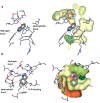Streptomyces zaomycetitus strain GH90: a source of violet pigment with metabolic profiling and potential application in textile: in vitro supported by in silico studies and molecular docking
- PMID: 41044476
- PMCID: PMC12492711
- DOI: 10.1186/s12866-025-04329-1
Streptomyces zaomycetitus strain GH90: a source of violet pigment with metabolic profiling and potential application in textile: in vitro supported by in silico studies and molecular docking
Abstract
Dyes are used daily in the culinary, textile, paper, leather, and agricultural sectors. Synthetic colors pollute the environment and have harmful effects. Microorganism-produced pigments are more cost-effective and environmentally benign than animal, plant, and synthetic pigments. The present study focuses on isolating a pigment-producing actinomycete, a novel violet pigment produced by a local isolate strain identified as S. zaomycetitus GH90, using 16 S rRNA from Egyptian soil. Optimizing violet pigment yield necessitated the precise adjustment of various growth parameters. Streptomyces zaomyceticus GH90 achieved optimal production under specific conditions. pH 8.0, agitation at 180 rpm, temperature at 37 °C, 1.5% starch concentration, ammonium sulfate, dipotassium hydrogen phosphate, 2% inoculum, 20% medium volume, and a 10-day incubation period. Ethanol served as the solvent for pigment extraction. Thermal analysis indicated no degradation at 40 °C. At 50 °C, retention was 98.7% and remained stable at 97.5% when subjected to temperatures between 60 and 80 °C for 1 h. Retention remained above 91% at temperatures of 90 and 100 °C, indicating significant heat stability. The pigment preserved its color integrity in an aqueous solution at pH 8.0. The UV-Vis spectra exhibited a maximum wavelength (λmax) at 580 nm. LC-MS analysis revealed the presence of indole, scopoletin, myricetin, and phosphorylated compounds, which are likely contributors to color and bioactivity. The pigment exhibited superior textile dyeing characteristics, including vivid coloration, high durability, and significant antibacterial activity, establishing it as a versatile and effective dye for antimicrobial textiles. Moreover, the most prevalent molecule, has high permeability, moderate solubility, and selective enzyme interactions, making it a suitable therapeutic candidate. Molecular docking shows significant OMPA and OprD binding affinities, supported by hydrophobic, π-π stacking, and hydrogen bond interactions. The obtained results clearly show how important Streptomyces is as a source of bioactive metabolites with potential applications.
Keywords: Streptomyces sp.; And molecular docking; Fermentation conditions; Textile printing; Violet pigment.
© 2025. The Author(s).
Conflict of interest statement
Declarations. Ethics approval and consent to participate: Not applicable. Consent for publication: Not applicable. Competing interests: The authors declare no competing interests.
Figures









References
-
- Slama HB, Bouket AC, Pourhassan Z, Alenezi FN, Silini A, Cherif-Silini H, Oszako T, Luptakova L, Goli ´nska P, Belbahri L. Diversity of synthetic dyes from textile industries, discharge impacts and treatmentmethods. Appl Sci. 2021;11:6255. 10.3390/app11146255.
-
- Sarmiento-Tovar AA, Silva L, Sánchez-Suárez J, Diaz L. Streptomyces-derived bioactive pigments: ecofriendly source of bioactive compounds. Coatings. 2022;12:1858. 10.3390/coatings12121858.
-
- Sharma D, Kaur T, Kaur V, Manhas R. A sustainable alternative: violet pigment from Streptomyces DP6 for textile applications. J Adv Microbiol. 2025;25:146–59. 10.9734/jamb/2025/v25i5941.
-
- Kim YE, Matter IA, Lee N, Jung M, Lee YC, Choi SA, Lee SY, Kim JR, Oh YK. Enhancement of Astaxanthin production by haematococcuspluvialis using magnesium aminoclay nanoparticles. Bioresour Technol. 2020;307: 123270. 10.1016/j.biortech.2020.123270. - PubMed
MeSH terms
Substances
LinkOut - more resources
Full Text Sources
Research Materials
Miscellaneous

